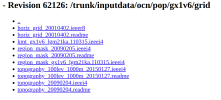Hi!
I'm trying to run CESM2 with the following compset: 2000_CAM60_SLND_CICE_DOCN%SOMAQP_SROF_SGLC_SWAV, which is unsupported. It is hoped to be an aquaplanet slab ocean mode with sea ice. However, I found that there was only cam output without cice output (history files, log files, restart files). It seems that I did not turn on the sea ice component successfully. I made no changes in user_nl_cice file. I'm wondering how can I solve this problem.
Thank you so much!
Best,
Rose
I'm trying to run CESM2 with the following compset: 2000_CAM60_SLND_CICE_DOCN%SOMAQP_SROF_SGLC_SWAV, which is unsupported. It is hoped to be an aquaplanet slab ocean mode with sea ice. However, I found that there was only cam output without cice output (history files, log files, restart files). It seems that I did not turn on the sea ice component successfully. I made no changes in user_nl_cice file. I'm wondering how can I solve this problem.
Thank you so much!
Best,
Rose

